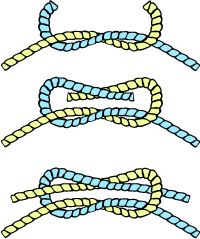Difference between revisions of "Translations:AY Honors/First aid/Cravat bandage to head/1/es"
From Pathfinder Wiki
m (FuzzyBot moved page Translations:Adventist Youth Honors Answer Book/First aid/Cravat bandage to head/1/es to Translations:AY Honors/First aid/Cravat bandage to head/1/es without leaving a redirect: Part of translatable page "Adventist Youth Honors Answer Book/First aid/Cravat bandage to head") |
|
(No difference)
| |
Latest revision as of 02:12, 8 September 2021
Este vendaje es útil para controlar el sangrado de las heridas en el cuero cabelludo o en la frente. Después de colocar una compresa sobre la herida, coloque el centro del pañuelo sobre la compresa y lleve a los extremos al lado opuesto; crúcelas, siga llevando a su alrededor para el punto de partida, y amarre con un nudo llano.
| Nudo llano |
|---|
|
Uso: También conocido como el nudo rizo o cuadrado, el nudo llano se aprende fácilmente y es útil para varias situaciones. Es usualmente utilizado para atar dos cuerdas o sogas juntas en sus extremos. Este nudo se utiliza en el mar en rizos y enrollar velas. Se utiliza en primeros auxilios para atar una venda o un cabestrillo debido a que el nudo queda plano.
Cómo amarrar:
ADVERTENCIA: No confíe en este nudo para soportar el peso en una situación de vida o muerte. Se ha conocido a desamarrarse.
|


